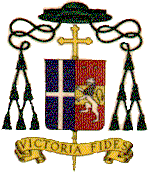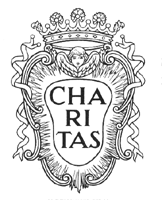
Arms of H.E. cardinal Francis George, archbishop of Chicago; see more explanations.
Warning: some of the heraldic prescriptions described here are out of date.
See also
The main peculiarities of ecclesiastical heraldry lie in the use of timbres to mark ranks and positions within the Church. A summary is presented here.
The distinguishing timbre of the pope is the three-crown tiara and the keys or and argent per saltire. This is discussed in greater detail separately.
Note that the tiara alone is used by the patriarch of Lisbon (title created in 1716 and held by the archbishop of Lisbon since 1740).
They surmount their coats of arms with a hat gules. From the hat hang a number of tassels (fiocchi), arranged so as to form triangles on both sides of the shield. The number of rows is 5. The hat was conceded to cardinals in 1245, and they started placing it in their achievements in the late 14th c. The number of rows of tassels increased steadily and was set at 5 in 1832.
A brief of Innocent X in 1644 prohibited cardinals from placing anything but their hat in their achievements, but this was frequently ignored, especially in France.
Until its 1969 edition, the Annuario Pontificio published an illustration of the arms of every member of the Roman Curia.

(See a site devoted to cardinals for more information on cardinals in general.)
The first marks of their rank was the crosier, and later the mitre. Bishops began using the hat in the late 16th c., and the use quickly spread, the number of tassels increasing over time. The current use, defined by the Congregation of the Ceremonial in 1832, is as follows:
In Italy, the hat completely replaced the mitre but in France, bishops often added on top of the shield (and below the hat) a mitre in dexter and a crosier in sinister. In the 18th c., archbishops often used 5 rows and bishops 4 rows.
Bishops with temporal powers usually indicated them in some fashion. In Germany, a crosier and a sword were placed in saltire behind the shield, and helmets bearing crests were placed on it. In France, the 6 (later 7) ecclesiastical peers placed the coronet of their title under the hat, and a peer's mantle behind the achievement. But other bishops held titles as well, such as count or baron, and used the appropriate coronet. The bishop of Le Puy was count of Velay and traditionally placed a sword in pale behind the shield. Otherwise, coronets indicating personal or family titles were prohibited in 1915.

Arms of the bishop of Rimini (Italy)
In Napoleonic heraldry prelates added the toque of their ranks (archbishops were counts, bishops were barons).
A decision of Dec 19, 1644 prohibited cardinals from exhibiting any secular dignities in the exterior ornaments of their arms. A decree of Jan 15, 1915 extended this decision and prohibited bishops from displaying any marks of personal nobility. A decree of May 12, 1951 prohibits all insignia of secular dignities, even those attached to the see or the function. The insignia of the Sovereign Military Order of Malta and the Order of the Holy Sepulcher are exempt.
An instruction of April 13, 1969 abolished the use of the crozier and mitre. Other arms on the Web:
Grant of arms to the bishop of Trento by the Emperor, 1339
The arms of 19th c. French bishops can be found in .
Generals of orders and abbots use a black hat with 3 rows. Curates or parish priests have a black hat with 1 row. Abbots sometimes are content with a mitre and a crosier, and an abbey's arms usually has a crosier per pale behind the shield.
See the American Benedictine Armorial for examples of arms of congregations.
These rules were very loosely applied, and it is frequent to see them ignored in the 17th-18th centuries.
Within the Catholic Church, no office specifically deals with heraldry. The Collegio Araldico in Rome is recognized by the Holy See but has no enforcement powers.
Under construction.

Order of Minims of S. Francis of Paola, who received the arms from S. Michael during a vision.
![]() Return to the Ecclesiastical
Heraldry Page.
Return to the Ecclesiastical
Heraldry Page.